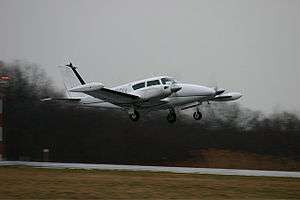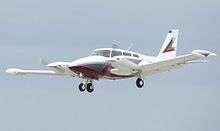Piper PA-30 Twin Comanche
| PA-30 Twin Comanche | |
|---|---|
 | |
| 1965 model Piper Turbo Twin Comanche with deicing boots installed | |
| Role | Cabin monoplane |
| Manufacturer | Piper Aircraft |
| First flight | November 7, 1962[1] |
| Number built | 2,142 |
|
| |

The Piper PA-30 Twin Comanche is an American twin-engined cabin monoplane designed and built by Piper Aircraft. It was a twin-engined development of the PA-24 Comanche single-engined aircraft. A variant with counter-rotating propellers was designated the Piper PA-39 Twin Comanche C/R.
Development
The Twin Comanche was designed to replace the Piper Apache in the company's lineup of products. The Twin Comanche was developed from the single-engined Comanche by Ed Swearingen who at the time operated a facility that specialized in the modification of production aircraft. The normally aspirated aircraft was equipped with two 4-cylinder 160 hp (120 kW) Lycoming IO-320-B1A fuel injected engines, but 200 hp (150 kW) engines were available as a modification by Miller Aviation. A version with turbocharged engines for higher altitude flight was also developed, using IO-320-C1A engines of the same nominal power. All Twin Comanche engines have long times between overhaul (2000 hours for the B1A, 1800 for the IO-320-C1A)[2] and have developed a reputation for reliability. The PA-39 was a version with counter-rotating engines (to eliminate the critical engine) that replaced the PA-30 in the early 1970s. The Twin Comanche was produced on the same Lock Haven, Pennsylvania production line as its single-engined cousin; production ceased when the factory was flooded in 1972. Piper chose at that time to focus on its equally popular Cherokee 140/180/235/Arrow line, manufactured in Florida, and its highly popular twin-engined Seneca, which is essentially a Twin Cherokee Six. The Piper PA-40 Arapaho had been scheduled to replace the PA-39 in the 1973-4 timeframe. Three were manufactured, and the aircraft was already fully certified when the decision was made not to proceed with the manufacture. One of the three Arapahos was destroyed in a flat spin accident in 1973; the test pilot, Clay Lacy, successfully escaped. One was scrapped by Piper and none remain registered with the Federal Aviation Administration as of May 2016.[3]
Design
The Twin Comanche is a low-wing cantilever monoplane with a retractable tricycle landing gear. With tip tanks, the aircraft holds 120 gallons (454 l) of fuel. Fuel burn at typical cruise settings is approximately 16 gph (58.7 lph) with a cruise speed of 165 kts. It easily climbs to 18,000 feet (5,500 m) when desired (24,000 feet - 7,300 m - if turbocharged). When compared with the Seminole, the Twin Comanche goes faster, carries more, burns less fuel, climbs more rapidly and ultimately higher, is quieter. When compared to the Seneca, which is really quite a different aircraft, the more noticeable differences are in handling. Another contemporary competitor to the Twin Comanche was the Beechcraft Travel Air. A similar airplane in form and function was the Gulfstream American GA-7 Cougar, which went into production after the Twin Comanche's production run ended.
Operational history
The Twin Comanche suffered a number of Vmc (Velocity Minimum Controllable) loss-of-control accidents in the 1960s and early 1970s. Initially, focus was placed on the aircraft design and the FAA reacted by issuing an airworthiness directive changing the Vmc speed, though there was no change in the aerodynamics. At the time, well known aviation journalist, Richard Collins, was highly critical of the FAA's multiengine training standards which encouraged unsafe Vmc demonstrations at low altitude.[4] Collins pointed out in another article that year that one FBO had suffered four fatal Vmc roll-over spins. Two were in a Twin Comanche, One in a Beech Travel Air and one in a Beech Baron.[5] It is not surprising that the Twin Comanche had a higher number of such accidents as it was used more often as a training aircraft. The FAA performed a series of flight tests on the Twin Comanche and NASA conducted wind tunnel tests and found no unusual tendency to spin beyond what would normally be expected given the airflow of the normally rotating propellers.[6]
In the 1970s, the FAA changed its training standards and required flight instructors to obtain a separate rating to teach in multiengine aircraft. The Vmc accidents dissipated dramatically. In 1997, the Aircraft Owners and Pilot's Association ("AOPA") Air Safety Institute published a safety review of the Comanche series aircraft and concluded that the Twin Comanche showed no greater tendency for Vmc roll-over spins than comparable aircraft.[7] Kristin Winter, a long time Twin Comanche instructor, operator, and trained accident investigator, reviewed the NTSB records for a ten year period ending in 2014 and concluded that the Air Safety Institute's report was correct in its conclusions. Of the six single engine loss of control accidents, most resulted from inexperienced pilots and substandard training.[8]
Prince William of Gloucester bought a Twin Comanche and used it as his personal aircraft for several years in the 1960s. He flew it from the United Kingdom to Nigeria, where he held a diplomatic post; then later returned in it to the United Kingdom and flew it to Japan when he took up a diplomatic post in that country.[9]
A Twin Comanche was flown in the 1992 and 1994 French Arc en Ciel air races. It is the only US aircraft to have raced twice around the world. In the pilot-skilled races, 1992 pilot and Pioneer Hall of Fame enshrinee and 100 Aviation Hero for the First Century of Flight, Marion P. Jayne and her daughter Nancy Palozola placed second. In 1994 Jayne and her daughter, Patricia Jayne (Pat) Keefer won the FAI Gold Medal in what, so far, is the longest race in history at over 21,000 miles flown May 1–24, 1994. With FAA approval the twin carried a total of 252 gallons in 11 tanks and at maximum power went over 2,100 miles nonstop between Marrakech, Morocco and Istanbul, Turkey in 11:19 hours.[10]
Variants
Three versions of the PA30 were produced: the original, a B model, and a C model. The B and C models can carry six passengers and can be identified by the additional side windows. Factory turbocharged engines became available with the B model. Turbo models can be identified by the presence of vents on the nacelle sides. These use Rajay turbochargers with manual wastegates operated by twin knobs under the throttle quadrant. They are properly termed "turbonormalized" since the compression ratio and maximum manifold pressure remained unchanged. Pilots are required to use care to avoid overboosting at low altitudes, since no overboost popoff valves are used. Since there is no accompanying power increase, the B/C models simply give owners a fuel vs. passenger tradeoff. The two rearmost seats, occupying the baggage compartment, are quite small.
- PA-30 Twin Comanche
- Four-seat twin-engined cabin aircraft. PA-24 with engine removed and nose faired in and powered by two 160-hp (119-kW) Lycoming IO-320-B1A engines in wing-mounted nacelles. Optional turbos were Rayjay models as on later iterations, but kept the B1A version of the engines.
- PA-30B Twin Comanche
- PA-30 with a third cabin window on each side and an optional fifth or sixth seat.
- PA-30B Turbo Twin Comanche
- Turbonormalized version of the PA-30B Twin Comanche, powered by two Rayjay turbonormalized IO-320-C1A piston engines.
- PA-30C Twin Comanche
- Twin Comanche B with new instrument panel, switches, and other minor variations. Optional turbonormalized version.
- PA-30-200 Twin Comanche B
- Experimental PA-30 with two 200hp Lycoming engines, one only from Piper.
- PA-39 Twin Comanche C/R
- PA-30 with counter-rotating 160hp Lycoming IO-320-B1A engines and modified wing leading edges.
- PA-39 Turbo Twin Comanche C/R
- Turbocharged version of the PA-39 Twin Comanche C/R.
- Piper PA-40 Arapaho
- Developed and fully certified version of PA-39 with entirely different wing and extensive fuselage modifications. Three prototypes only.
Specifications (PA-39)
Data from The Illustrated Encyclopedia of Aircraft (Part Work 1982-1985), 1985, Orbis Publishing, Page 2735
General characteristics
- Capacity: four/six seat
- Length: 25 ft 2 in (7.67 m)
- Wingspan: 36 ft 9½ in (11.21 m)
- Height: 8 ft 3 in (2.51 m)
- Wing area: 178 ft2 (16.54 m2)
- Empty weight: 2270 lb (1030 kg)
- Gross weight: 3725 lb (1690 kg)
- Powerplant: 2 × Avco Lycoming IO-320-B1A flat-four piston engine with counter-rotating propellers, 160 hp (119 kW) each each
Performance
- Maximum speed: 205 mph (330 km/h)
- Range: 1200 miles (1931 km)
- Service ceiling: 20,000 ft (6095 m)
See also
- Related development
References
- Notes
- ↑ Pilotfriend
- ↑ Lycoming Service Instruction 1009AV, dated July 13, 2013.
- ↑ Federal Aviation Administration (6 May 2016). "PA-40 Make / Model Inquiry Results". Retrieved 6 May 2016.
- ↑ Collins, Richard, "What about the Twin Comanche?", Flying, March 1969, p. 46.
- ↑ Collins, Richard, "Safety check", Flying, October 1969, p. 96.
- ↑ Winter, Kristin, "The Twin Comanche: "Safety facts and best practices", Piper Flyer, March 2016, p. 50.
- ↑ Air Safety Institute, Piper Comanche Safety Review, November 1, 1997.
- ↑ Winter, The Twin Comanche, p. 51
- ↑ "HRH Prince William of Gloucester", Flight International, September 7, 1972, p.341a (online archive version) retrieved August 13, 2012
- ↑ First Flight Foundation (December 2003). "Honoring 100 Aviation Heroes Tuesday, December 16". Retrieved December 18, 2010.
- Bibliography
- The Illustrated Encyclopedia of Aircraft (Part Work 1982-1985), 1985, Orbis Publishing
External links
![]() Media related to Piper PA-30 Twin Comanche at Wikimedia Commons
Media related to Piper PA-30 Twin Comanche at Wikimedia Commons